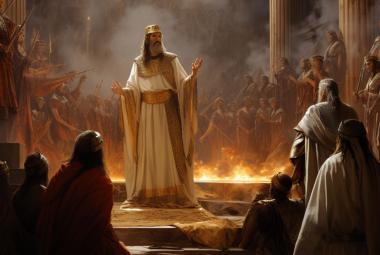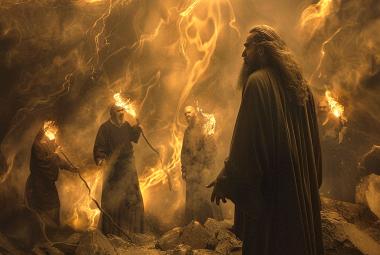“There are two burdens every aspiring critical thinker must consider when making or evaluating an argument—the evidentiary burden and the persuasive burden.“1 Underlying these burdens are several duties necessary to meet them—in this article, we will consider what I call “the Duty to Define.“ Words and phrases form the foundation of any argument and when their meaning is ambiguous or duplicitous, so is the position that relies on these words or phrases.
Have you ever said, “Jesus bless you“ rather than “God bless you“ to a stranger or even to an acquaintance? For the Christian, Jesus is God and God is Jesus. Consider what Jesus said about Himself, “I and the Father are One.“2 John’s Gospel begins with the concept that, “The Word was God. The Word dwelt among us.“3 And yet, even though the believer would agree that the two phrases are synonymous, the lack of specificity of the phrase “God bless you“ can be a more comfortable salutation. (Come on, admit it! Or better yet, try it and see what you think!)
Legislation underscores the importance of defining words. The word “definition“4 appears one hundred seventy-one (171) times in the Patient Protection and Affordable Care Act of 2010.5 The subsequent legal and political challenges faced by what is commonly referred to as “Obamacare“ were convoluted enough. Without these definitions embedded throughout the text of the legislation, its meaning and intent would be indiscernible and incomprehensible.
In a New York State law with considerably less verbiage – dubbed “The Taylor Law“6 – section two hundred one (§2017) is titled “Definitions.“ This section includes twelve (12) paragraphs, some of which contain sub-paragraphs! Our lawmakers understand the need for defining terms and phrases!
The study of mathematics begins with definitions8—the definition of a rectangle or of a quadratic equation or of a matrix. Some of our gracious readers may remember doing two column geometry proofs while attending secondary school. You may shudder at their recollection! A simple example is provided below if you can overcome the horror!
Statement | Reasons |
|
|
Notice the reliance on definition in the proof and before that in the law. Critical thinkers – whether legal, mathematical or political – must be clear on the definitions of words used by the speaker and while speaking. We have all been a part of conversations where we seem to be talking past each other and very often this results from a misunderstanding of use of a word or phrase. From Wikipedia:
“In parliamentary procedure, the verb to table has the opposite meaning in different countries: In the United States, to ‘table’ usually means to postpone or suspend consideration of a pending motion. In the rest of the English-speaking world, to ‘table’ means to begin consideration (or reconsideration) of a proposal.“9
In August, CNN correspondent Omar Jimenez reported from Kenosha, Wisconsin. Behind him, fire engulfed automobiles and buildings while the chyron read “FIERY BUT MOSTLY PEACEFUL PROTESTS AFTER POLICE SHOOTING.“10 Social media jumped on this with many memes and posts focusing on the “fiery“ while others focused on the “mostly peaceful protests.“ Rather than take sides, the critical thinker who embraces the “duty to define“ described herein asks the questions:
- What is meant by “mostly?“
- What is meant by “peaceful?“
- What is meant by “protest?“
“Mostly“ requires some sort of quantification. Is it being used synonymously with “majority“ and means more than fifty (50%) percent? Is it intended to convey a near “unanimity“ and means nearly one hundred (100%) percent? Or does it lie somewhere in between? And if so, where is the in-between point? Let’s say that there were 100 people, and 75 of them can be described as peaceful protestors – that means 25 of them are not. Is the definition of mostly peaceful protests satisfied with 75% compliance? And how would we know? Was there somebody reliably determining who was peaceful and who was unpeaceful.
The duty to define requires more questioning. What is peaceful? What is protest versus what is riotous? Is there general agreement that any unlawful act leading to damage, destruction, or death is considered unpeaceful protesting? If the damage is caused only during a four (4) hour period from (say) 10:00 pm to 2:00 am, does that mean satisfy the definition of a “mostly peaceful protest?“ After all, for twenty of the twenty-four hours there was no violence – that is over eighty (80%) percent of the time that things were peaceful.
I can go on and on with this, and I am unashamed to admit that I have. When I hear things—and especially terms and phrases—I start asking questions. Those around me get exasperated as I begin my journey to define terms and phrases rather than react to them. With this duty to define comes a commitment to understand. “So then, my beloved brethren, let every man be swift to hear, slow to speak, slow to wrath.“11 “He who answers a matter before he hears it, It is folly and shame to him.“12
Whether the discipline described above is sufficient to successfully engage in conversation that is factual and persuasive is beyond the scope of this article. My training as a mathematician and as a legal advocate have cooked it into my thinking. And I am pretty sure that our Heavenly Father is pleased by the diligence.
“Do you not know that we shall judge angels? How much more things that pertain to this life? If then you have judgments concerning things pertaining to this life, do you appoint those who are least esteemed by the church to judge? I say this to your shame. Is it so, that there is not a wise man among you, not even one, who will be able to judge between his brethren?“
1 Corinthians 6:3-5
Notes:
1 “Critical Thinking“ by Chris Corlett, Free download available: https://store.khouse.org/products/critical-thinking
2 John 10:30 (NKJV)
3 Adapted from John 1:1,14
4 or some variant like “definitions“
5 Based on the document available at: http://housedocs.house.gov/energycommerce/ppacacon.pdf
7 Despite the numbering system employed within the legislation, it is the second section of the law.
8 Along with axioms or postulates.
10 Widely reported and one source is https://www.foxnews.com/media/cnn-panned-for-on-air-graphic-reading-fiery-but-mostly-peaceful-protest-in-front-of-kenosha-fire
11 James 1:19 (NKJV)
12 Proverbs 18:13 (NKJV)





